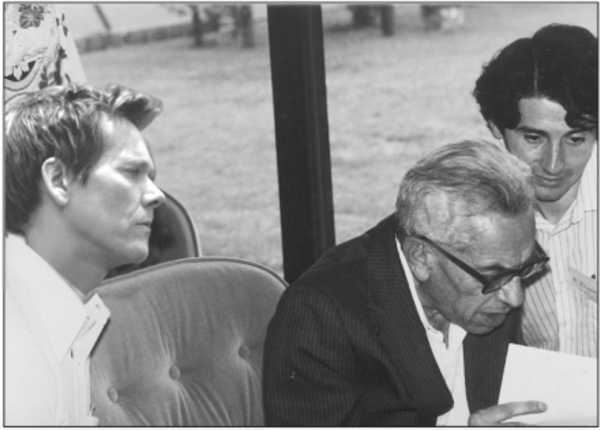
Previously unseen footage has been unearthed by The Aperiodical’s crack team of investigative journalists of Kevin Bacon and Paul Erdős writing a paper together, and a still from this is shown above. This has massive consequences for the important topics of Erdős numbers, Bacon numbers and Erdős-Bacon numbers.
At the cutting edge of mathematical research, Erdős numbers are assigned to people who collaborated on a paper with Erdős or with someone who has an Erdős number. Erdős has, by definition, an Erdős number of zero. People who collaborated with him have an Erdős number of 1, people who collaborate with them have an Erdős number of 2, and so on.
Bacon numbers work similarly for people who appeared on film with Kevin Bacon, and like Erdős, Kevin Bacon has been chosen as the centre of this network, due to his large number of film appearances. Kevin Bacon similarly has a Bacon number of zero.
Erdős-Bacon numbers are assigned to people who have both an Erdős number and a Bacon number, and are simply the sum of the two numbers.
The fact of them collaborating on a paper gives Bacon an Erdős number of 1, and the fact that this was filmed gives Erdős a Bacon number of 1 (previously, his Bacon number was 5, through a chain including Ronald Graham, Merce Cunningham, Dennis Hopper and Chris Penn). This means Erdős and Bacon both have an Erdős-Bacon number of 1, the lowest possible number which, before this footage was discovered, was a value thought to be impossible. This new property of Erdős-Bacon numbers has consequences in Yang–Mills theory and may even provide a hint at a new approach to solving the Riemann hypothesis.
The brief footage of the collaboration was found in unused material filmed for the 1993 documentary N Is a Number: A Portrait of Paul Erdős. Filmed over a four-year period in four countries between 1988 and 1991, the documentary explores his career, personal life and sense of humour.
…and that bloke on the right is me during my sophomore year of college pointing out an error in step 29 of some proof.